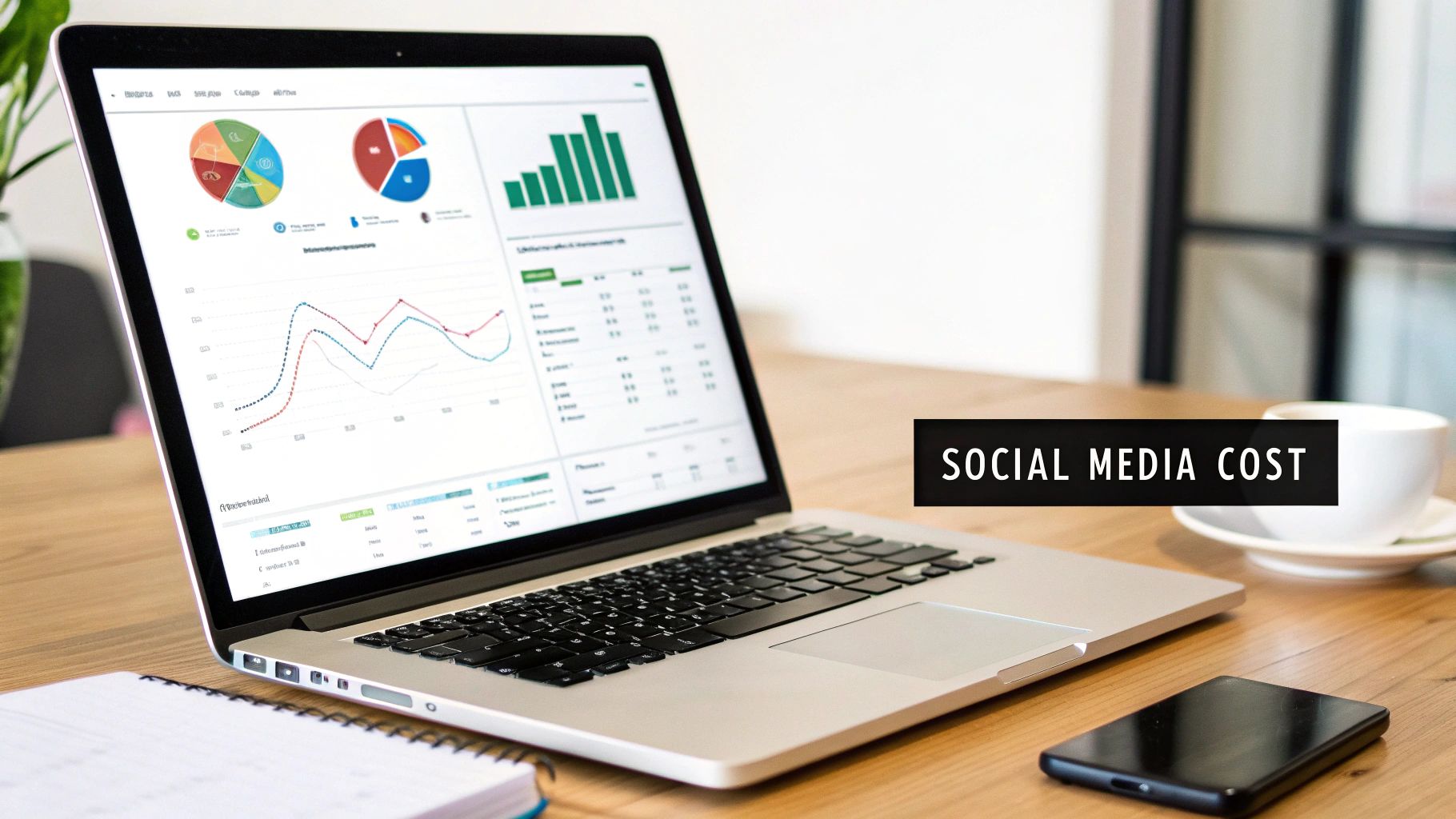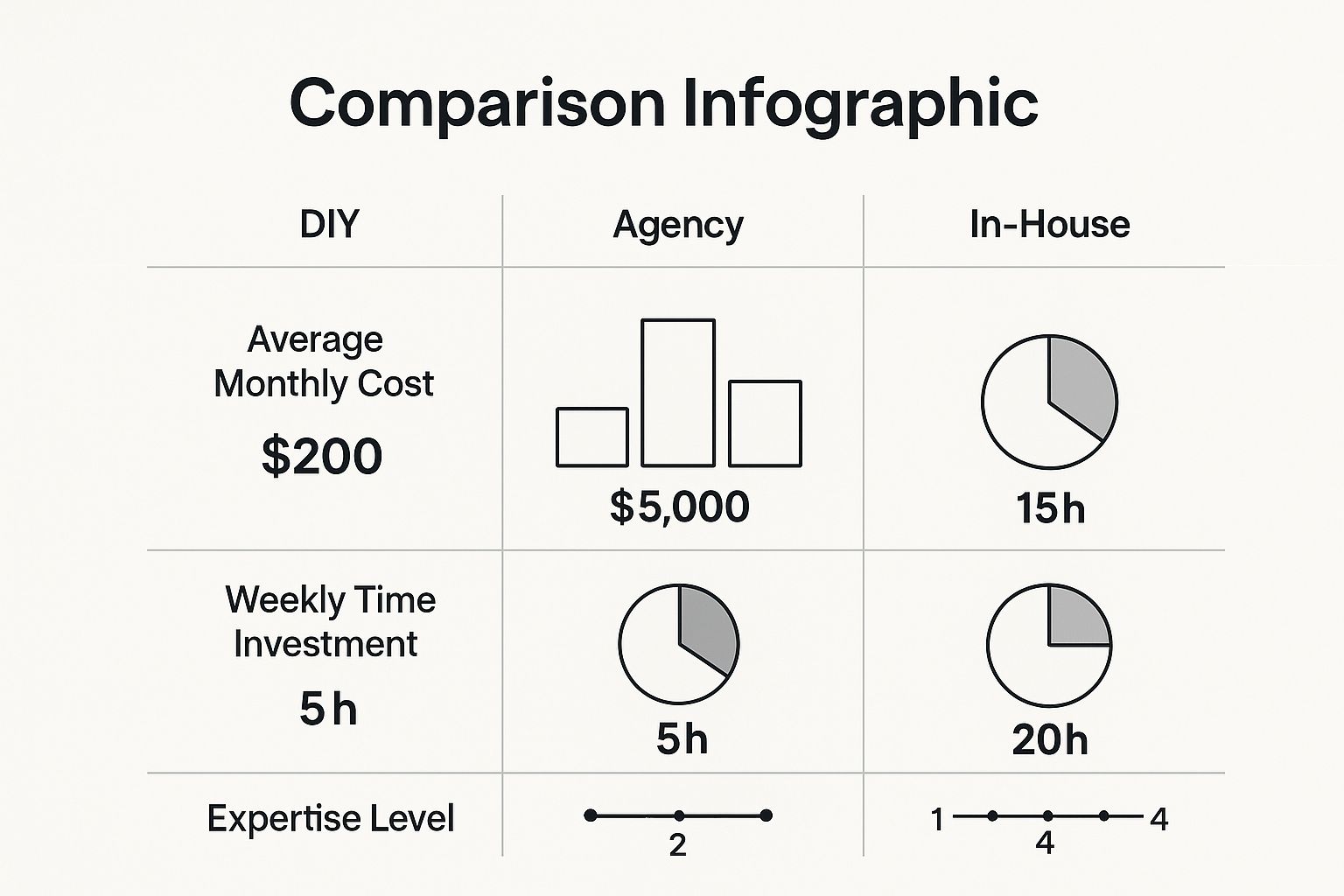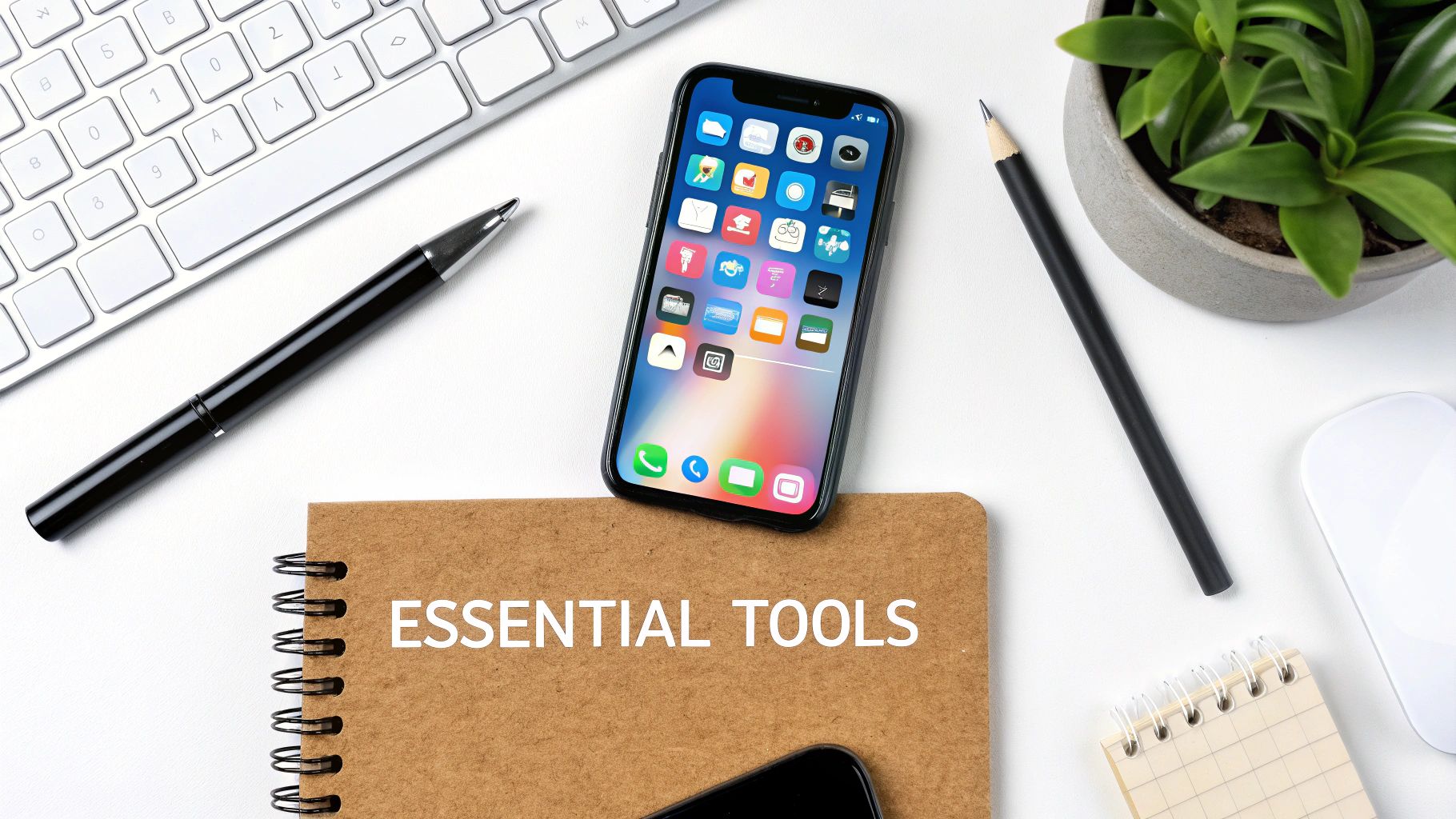Trying to nail down a single price for social media management is a bit like asking, "How much does a car cost?" Well, are we talking about a reliable daily driver or a souped-up performance machine? The answer is always: it depends.
You could be looking at anywhere from $500 a month to well over $10,000. The final number really boils down to what your business needs, the scope of the work, and whether you're bringing on a freelancer, an agency, or a full-time employee.
What Does Social Media Management Really Cost?

The investment you make is tied directly to your goals, how complex the work is, and the level of expertise you need to get the job done right.
Think about your digital presence like any other part of your business. You budget for a website, right? Social media deserves that same intentional planning. For a little perspective on how these digital investments stack up, you can check out our guide on website design costing.
Ultimately, you get what you pay for. A smaller budget might cover the basics, like getting posts scheduled and out the door. A bigger budget, on the other hand, can fund a full-blown strategy—we're talking original content creation, daily community engagement, and a powerful paid ad machine working for you.
A Financial Snapshot by Business Size
For most small businesses, a realistic social media management budget falls somewhere between $500 and $5,000 per month. This typically gets you the essentials: account management, content creation, and someone keeping an eye on your community.
For businesses with bigger ambitions—maybe you're launching multi-platform video campaigns or pouring serious money into paid ads—it’s not uncommon to see costs climb past $10,000 a month. That budget is what fuels serious online visibility and growth.
The best way to look at social media management is not as a cost, but as an investment. You're investing in your brand's voice, its reach, and the relationships you build with your customers.
Your budget is the engine for your social media. To give you a clearer idea of what to expect, let's break down the typical costs and services based on business size.
Average Monthly Social Media Management Costs By Business Size
Here’s a quick overview to help you gauge what a realistic monthly investment looks like for your business and what you can expect to get for it.
| Business Size | Typical Monthly Cost Range | Common Services Included |
|---|---|---|
| Small Business / Startup | $500 – $2,500 | 2-3 platforms, basic content creation, community monitoring |
| Medium-Sized Business | $2,500 – $7,500 | 3-5 platforms, advanced content (video/graphics), basic ad management |
| Large Enterprise | $7,500 – $20,000+ | All platforms, full-scale content production, advanced analytics, robust ad campaigns |
This table should give you a solid starting point. As your business grows and your goals evolve, your investment will likely scale right along with them.
Choosing Your Social Media Management Path

One of the biggest levers on your social media budget is deciding who is going to do the work. This choice doesn’t just affect the cost; it sets the tone for your strategy, your day-to-day workflow, and ultimately, your results. You've got three main routes to consider.
Think of it like getting around town. You could buy a car, hire a private driver, or just grab an Uber when you need one. Each gets you from A to B, but the experience, control, and cost are worlds apart.
Hiring an In-House Team
This is the "buy the car" option. It’s the biggest investment, both upfront and ongoing, but it gives you total control. You’re not just paying a salary here. You’re also on the hook for benefits, payroll taxes, software licenses, and ongoing training.
The huge upside? An in-house social media manager is 100% focused on your brand. They’re immersed in your company culture every single day, which often leads to incredibly authentic and lightning-fast content. But you have to account for the true cost:
- Salary and Benefits: A social media manager's salary can easily run from $50,000 to over $85,000 a year, and that’s before you tack on benefits.
- Overhead: Think about the cost of a new laptop, desk space, and all the essential software subscriptions they’ll need.
- Training: The social media world changes constantly. You'll need to invest in keeping their skills sharp and up-to-date.
This is the best path for businesses that need someone living and breathing their brand and have the budget to fully support a full-time role.
Partnering With a Social Media Agency
Hiring an agency is like having that private driver—or maybe a whole motorcade—on call. You get an entire team of specialists for a predictable monthly retainer. Suddenly, you have a strategist, a copywriter, a designer, and an ads pro in your corner, a powerhouse team that's incredibly difficult (and expensive) to hire one by one.
Agencies bring a ton of experience from working across different industries, offering a valuable outside perspective you just can't get from inside your own walls. While the monthly fee might look steep at first glance, it completely eliminates all the overhead that comes with an employee. Choosing the right one is a big deal, and our guide on how to choose a creative agency can walk you through that process.
An agency partnership gives you access to a diverse, high-level skill set without the long-term commitment and hidden costs of building out an internal team. You're investing in strategic execution from day one.
This route is perfect for companies that want comprehensive, expert-led management and are ready to invest in a consistent monthly partnership.
Working With a Freelancer
Think of a freelancer as your on-demand Uber. You bring in specialized talent for exactly what you need, right when you need it. It could be for a single campaign launch or for ongoing, part-time management. This is often the most flexible and budget-friendly choice of the three.
Freelancers usually charge by the hour or offer monthly packages, and the rates vary wildly depending on their experience and the scope of work. For example, a solid freelancer might offer a full-service package for around $700 per month to handle a couple of platforms, write content, and engage with your community. You can get a better feel for the market by looking into social media management pricing benchmarks to see how different services stack up.
What Actually Drives Your Final Bill?
Ever wonder why one business pays a few hundred dollars a month for social media while another shells out thousands? That price gap isn't random—it's a direct reflection of the work involved. Think of it like building a house. A simple one-story starter home has a very different price tag than a custom-built mansion with an infinity pool and a home theater.
Every service you add is another room, another feature, another layer of complexity that adds to the final bill. Once you get a handle on these key variables, you can put together a social media plan that actually hits your marketing goals without blowing up your budget.
Let's break down the biggest cost drivers.
Scope of Work and Services
The most fundamental factor is simply what you need done. Is this a simple hand-off, or are you looking for a deep partnership? A basic package might just cover scheduling posts you've already written. A comprehensive one is a whole different ballgame.
Your investment will climb as you add on services like:
- Strategy Development: This isn't just posting—it's crafting a detailed plan that nails down your target audience, key messages, and what success actually looks like.
- Content Creation: This is a big one. It involves everything from designing graphics and writing captions to shooting and editing videos.
- Community Engagement: Actively responding to comments, DMs, and mentions. This is the stuff that builds real relationships with your audience.
- Reporting and Analytics: Pulling all the data together, tracking key performance indicators (KPIs), and turning numbers into actionable insights.
A simple content scheduling service might only run you a few hundred dollars. But a full-service package that covers all of the above? That can easily get into the thousands.
Content Creation Complexity
Let's be real: not all content is created equal. The type and quality of the assets you need will dramatically swing your social media management cost. Firing off a text-only post for LinkedIn takes a fraction of the effort needed to produce a polished, 60-second video for TikTok.
The more sophisticated your content needs are, the higher the cost. Video production, custom graphic design, and professional photoshoots are specialized skills that demand a bigger budget.
For instance, if your strategy depends on high-quality, original photos, you'll also need to budget for photography. That's often a separate but related expense, and you can get a better idea of what to expect from our breakdown of how much photoshoots cost.
Number of Social Media Platforms
Managing a single Instagram account is a world away from running a presence across Instagram, Facebook, LinkedIn, X (formerly Twitter), and TikTok. Each platform is its own universe with unique best practices, audience expectations, and content formats.
More platforms mean more time spent on:
- Tailoring Content: You can't just copy-paste. Good management means repurposing and optimizing posts for each channel’s algorithm and user base.
- Scheduling and Publishing: Juggling multiple content calendars and posting schedules gets complicated fast.
- Monitoring and Engaging: Keeping track of conversations and responding to your community across completely different environments.
As a rule of thumb, every platform you add to the mix will increase the overall management fee.
Paid Advertising Management
Finally, running paid ad campaigns is a huge cost multiplier. Bringing paid social into the picture requires a specialized skill set that goes way beyond organic posting.
This service involves creating ad copy and visuals, building razor-sharp target audiences, managing bids, and constantly tweaking campaigns to get the best results. Agencies and freelancers usually charge for this in one of two ways: either as a percentage of your monthly ad spend (typically 10-20%) or as a flat management fee on top of your monthly retainer.
Just remember, this fee is for their expertise and management—it doesn’t include the actual ad budget you'll be paying directly to the social media platforms.
Decoding Social Media Pricing Models
Figuring out how you'll be charged for social media management is just as crucial as knowing what you'll pay. Agencies and freelancers structure their fees in a few different ways, and the right one for you really depends on your business goals and needs.
Think of it like paying for a meal out. You could pay per dish (hourly), go for the fixed-price menu (project-based), or sign up for a weekly meal delivery subscription (monthly retainer). Each one makes sense in a different scenario. Let's break down the most common models so you can find the perfect fit.
Comparing Social Media Management Pricing Models
To make sense of it all, here's a quick look at the common pricing structures you'll run into. This table breaks down what each model is, who it's best for, and the honest pros and cons you should weigh before committing.
| Pricing Model | Best For | Pros | Cons |
|---|---|---|---|
| Monthly Retainer | Businesses needing consistent, ongoing social media management and long-term growth. | Predictable monthly costs make budgeting a breeze. Fosters a strong, strategic partnership. | Can be less flexible if your needs change suddenly. Requires a longer-term commitment. |
| Hourly Rate | Short-term projects, consultations, or businesses with fluctuating needs. | Pay only for the work you need. Great flexibility and low initial commitment. | Costs can become unpredictable if hours aren't tracked carefully. Less ideal for ongoing strategy. |
| Project-Based Fee | Specific, one-time campaigns with clear start and end dates (e.g., a product launch). | You know the total cost upfront, which is great for fixed budgets. Scope is clearly defined. | Can be less flexible if the project scope changes. Not suited for continuous management. |
| Performance-Based | Companies with aggressive growth goals and a high tolerance for risk. | You only pay for tangible results, directly linking cost to ROI. | Goals must be crystal-clear and trackable. Can be a risky model for the provider, leading to higher potential costs. |
Ultimately, the best model is the one that aligns with your budget, your goals, and the level of involvement you want. A retainer offers stability, while hourly and project-based options provide flexibility for more defined tasks.
The Predictable Monthly Retainer
This is the bread and butter for most social media agencies. You pay a set fee every month for a pre-defined list of services—things like content creation, community management, and monthly reports. It's built for consistency and allows you and your social media partner to build a real long-term strategy together.
A monthly retainer makes budgeting incredibly straightforward and guarantees your social media presence never goes dark. It’s the go-to for any business serious about sustained growth and brand management.
The Flexible Hourly Rate
This is classic freelancer territory, and it's simple: you pay for the time spent on your account. Rates can swing from $50 to over $150 per hour, depending entirely on the expert's experience and what you're asking them to do. It’s a perfect fit for quick-turnaround projects, one-off consultations, or if your needs just vary wildly from one month to the next.
If you’re just dipping your toes in or need a specialist for a specific task, hourly rates are a low-commitment way to get started. And for any freelancers reading this, figuring out where you land in that range can be tough; using a good freelance rate calculator can give you a solid starting point.
Project-Based and Performance Fees
A project-based fee is exactly what it sounds like: a single, flat rate for a specific campaign. Think a big product launch or promoting a local event. You know the exact cost from day one, which is a massive plus for projects with a clear finish line.
Then there’s the performance-based model—less common, but really interesting. Here, the fee is tied directly to results, like hitting a certain number of leads or a target conversion rate. This model forces everyone to focus on outcomes, but it demands airtight goals and rock-solid tracking to work.
This image below does a great job of comparing the real cost—in both time and money—of doing it all yourself versus bringing in an agency or hiring someone full-time.

As you can see, the DIY route might seem cheap, but it's a massive time sink and you miss out on professional expertise. It really highlights the trade-offs you make when deciding how to handle your social media.
Budgeting for Essential Social Media Tools

The fee you pay an agency or freelancer is just one piece of the puzzle. The other, often-overlooked part of your social media management cost is the tech stack they need to actually do the job. Great social media management isn’t just about clever posts and snappy captions; it relies on a powerful toolkit to execute those ideas day in and day out.
Think of it like hiring a master carpenter. You’re paying for their skill, but they still need their saws, drills, and measuring tapes to build anything. Social media tools are the digital equivalent, handling everything from scheduling content to diving deep into performance analytics.
Core Tools in the Social Media Stack
Honestly, trying to run a modern social media strategy without the right software is a non-starter. These tools save countless hours, deliver critical data, and help maintain a polished, consistent brand presence. Leaving them out of your budget is a recipe for inefficiency and completely missed opportunities.
A typical software stack includes tools for:
- Scheduling and Publishing: Platforms like Buffer or Hootsuite are lifesavers, letting you batch-create content and schedule it to post at the perfect times across all your channels.
- Analytics and Reporting: These tools go way deeper than the basic analytics you get on Facebook or Instagram, tracking the metrics that actually matter and helping prove your ROI.
- Content Creation: You need great visuals. Software for graphic design (like the ever-popular Canva) or video editing is non-negotiable for creating posts that stop the scroll.
- Collaboration and Approval: For teams, having a tool that streamlines the content review and client approval process is an absolute must-have.
Factoring in Software Subscription Costs
For most mid-sized businesses, you can expect to spend somewhere between $100 and $300 per month on software. To justify that cost, the platforms need to have solid collaboration features like user roles, approval workflows, and advanced reporting. You can get more detailed breakdowns of social media tool pricing on TrustRadius.
The right tools don't just add to your social media management cost—they generate ROI. By automating repetitive tasks and unlocking strategic insights, they free up your team to focus on high-impact activities that actually grow your business.
Many agencies will bundle these software fees right into their monthly retainer, while others might list them as a separate line item. When you’re looking at proposals, always make sure to ask how they handle tool costs.
Properly equipping your team is a fundamental expense. And for businesses looking to get the most out of their entire digital presence, checking out our list of small business marketing resources can give you even more great tools for your arsenal.
How to Set a Budget and Actually Measure Your ROI
Pouring money into social media without tracking what comes out is like trying to fill a leaky bucket. To make sure your investment translates into real, measurable growth, you need a smart budget and a rock-solid plan for tracking your return on investment (ROI).
First things first: forget vanity metrics. Likes and follower counts feel good, but they don't pay the bills. Instead, you need to define what success actually looks like for your business. Are you trying to generate 15 qualified leads every month? Or maybe you want to boost website conversions from your social traffic by 20%? Those are tangible goals you can build a strategy around.
Connecting Goals to Measurable KPIs
Once your business goals are crystal clear, you can pinpoint the key performance indicators (KPIs) that prove you're moving in the right direction. Think of KPIs as the data points that build a bridge between your social media activity and your bank account.
It’s pretty straightforward:
- Goal: Increase website sales. KPI: Conversion rate from social media links.
- Goal: Generate more leads. KPI: Click-through rate (CTR) on your lead magnet posts.
- Goal: Boost brand awareness. KPI: Reach, impressions, and your share of voice in the market.
As you plan your budget, it's also critical to know which channels give you the most bang for your buck. For instance, digging into different paid advertising strategies can have a massive impact on your overall social media ROI.
Calculating Your Social Media ROI
With clear goals and KPIs in hand, figuring out your ROI isn't so intimidating. The basic formula is the perfect place to start to see if your money is working for you.
(Profit from Social Media – Total Social Media Cost) / Total Social Media Cost x 100 = Social Media ROI %
Just remember, your "Total Social Media Cost" needs to include everything—the agency or freelancer fees, any software subscriptions, and every dollar spent on ads.
By tracking this number, you stop treating social media as just another expense. It becomes a powerful, data-backed investment that drives predictable growth for your business. This is how you get the clarity you need to not only justify your budget but optimize it for even better results down the line.
A Few Common Questions
When you're trying to figure out social media management costs, a few questions always seem to pop up. Let's tackle them head-on so you can budget with confidence and make the right call for your business.
How Much Should a Small Business Actually Spend?
For most small businesses, the sweet spot is somewhere between $500 and $5,000 a month. It’s a big range, I know. Where you land depends entirely on what you’re trying to achieve.
If you just need to keep the lights on—a basic presence on one or two key platforms—you’ll be on the lower end of that scale. But if you're chasing serious growth with video, running paid ad campaigns, and need detailed reporting, you should expect to invest closer to the top end.
Are Freelancers Cheaper Than Agencies?
The short answer? Usually, yes. Freelancers don't have the same overhead as a big agency, so their rates are often more budget-friendly.
But this isn't just a simple price comparison. Think of it this way: an agency is like hiring a whole pit crew—you get a strategist, a copywriter, a designer, and an analyst. A freelancer is like hiring a specialist mechanic who is an absolute master of one thing. The "cheaper" option really depends on whether you need that one expert touch or a full team behind you.
Does the Management Fee Include My Ad Budget?
This is a big one. Almost always, the answer is no.
The management fee you pay a freelancer or agency covers their time, expertise, and the work they do creating and managing your campaigns. Your ad spend is a separate cost that goes directly to the platforms themselves, like Meta or LinkedIn. Always, always clarify this when you're looking at a proposal to make sure there are no surprises down the line.
Ready to find the right social media pro for your budget? Creativize makes it easy to connect with talented local experts. Find your next creative partner and get started.

